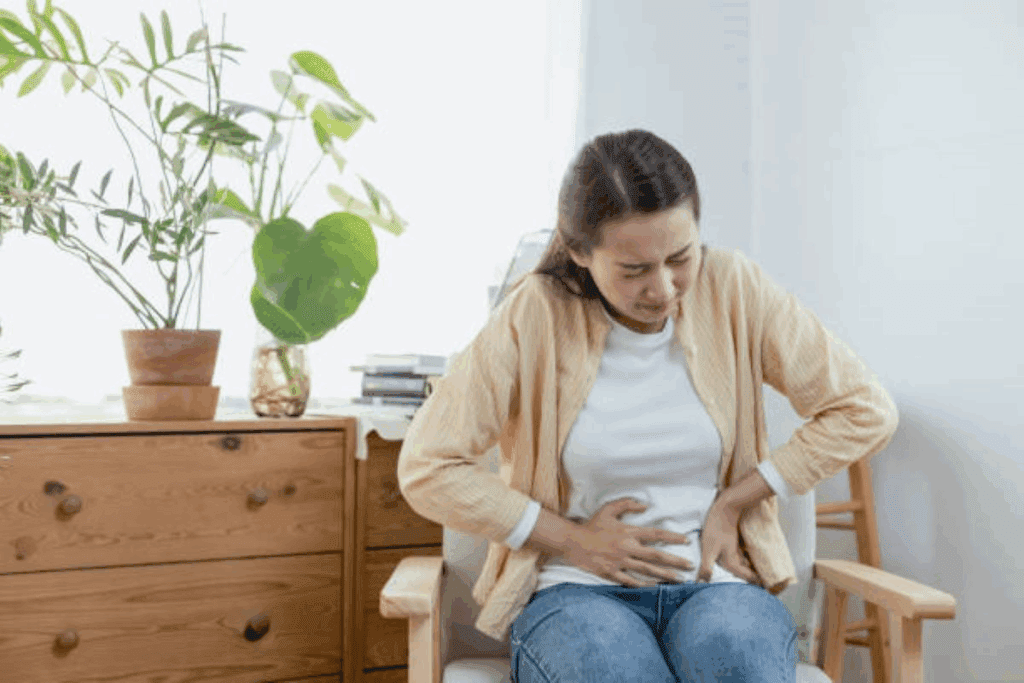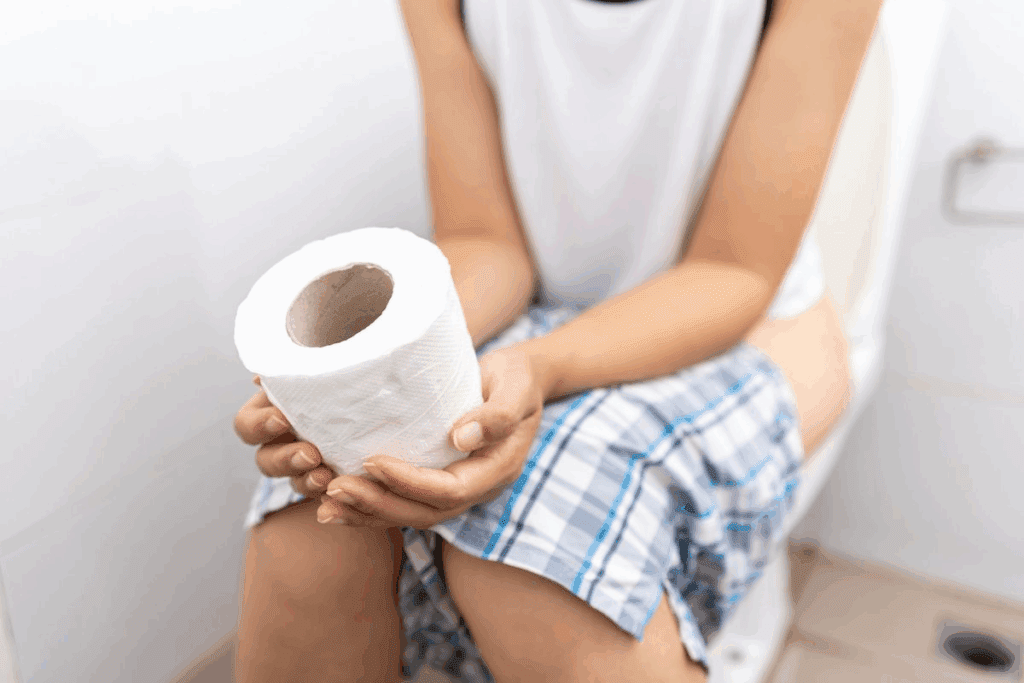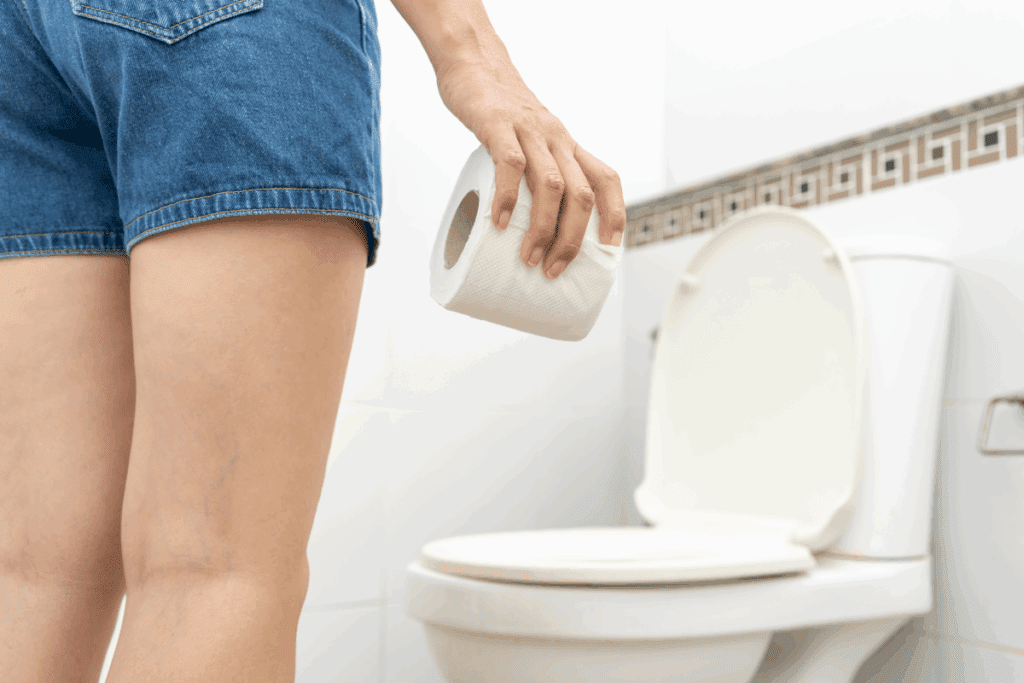Last Updated on October 30, 2025 by Bilal Hasdemir

At Liv Hospital, we know that diarrhea can be a sign of gallbladder problems. The gallbladder helps with digestion by storing bile. This bile is key for breaking down fats.
When the gallbladder doesn’t work right, it can cause digestive issues. This includes gallbladder diarrhea. You might see loose or watery stools, often right after eating. This is more common with fatty foods.
We understand how gallbladder problems can affect your stool. Many patients wonder, “can a bad gallbladder cause diarrhea?” Our team focuses on you, using advanced care to find and fix the cause of your symptoms.

The gallbladder plays a key role in digestion. It stores and releases bile, which is vital for breaking down fats. Bile comes from the liver and goes into the small intestine to help with digestion.
Knowing how the gallbladder works is important for good digestion. It mainly stores and concentrates bile. This bile is released into the small intestine when we eat fatty foods.
The gallbladder works closely with the liver and small intestine. When we eat fatty foods, a hormone called cholecystokinin (CCK) is released. This hormone makes the gallbladder contract and release bile into the small intestine.
Bile’s role in digestion is key. It breaks down fats into smaller pieces. This makes it easier for enzymes to digest fats and for our body to absorb them.
Bile does more than just break down fats. It also affects how solid or liquid our stool is. If we don’t make enough bile or if it can’t get out, our stool might become loose or watery.
| Bile Component | Function | Effect on Stool Consistency |
| Bile Salts | Emulsify fats | Improper emulsification can lead to diarrhea |
| Bilirubin | Gives bile its color | Affects stool color; abnormal levels can cause pale stools |
| Cholesterol | Excess can form gallstones | Indirectly affects stool through gallbladder dysfunction |
It’s important to understand how the gallbladder, bile, and digestion are connected. This knowledge helps us spot and treat problems with the gallbladder. By knowing how bile affects our stool, we can take steps to keep our digestion healthy.

A bad gallbladder can really mess with your digestion, often causing diarrhea. The gallbladder is key in digestion, storing bile from the liver. This bile helps break down fats into smaller bits for the body to absorb.
Gallbladder problems can lead to impaired bile release, messing up digestion. Without proper bile release, poor fat digestion happens. Undigested fats then cause diarrhea as they move to the colon for bacteria to ferment.
People with gallbladder disease often face digestive issues, like diarrhea. Studies show those with gallbladder problems have more gut symptoms.
“The presence of diarrhea in patients with gallbladder disease is a recognized sign that may indicate underlying issues such as gallstones or chronic gallbladder disease.”
Medical Research Findings
Research shows many gallbladder disease patients have digestive symptoms. For example, a study found:
These numbers highlight the direct link between gallbladder problems and digestive issues like diarrhea. Knowing this connection helps doctors diagnose and treat gallbladder issues better.
Diarrhea linked to the gallbladder has unique signs. Knowing these can help spot gallbladder problems. We’ll look at the main signs, like when it happens, how often, and what it looks like.
Gallbladder diarrhea often hits after meals, mainly after fatty foods. This timing is a big clue for gallbladder trouble. As Dr. John Smith, a gastroenterologist, notes, “The timing of diarrhea in relation to meals can be a key clue.”
“The gallbladder’s role in storing and releasing bile is closely linked to meal times, specially when fatty foods are eaten. When this process is disrupted, it can lead to diarrhea.”
People with gallbladder issues might get diarrhea a few hours after eating. This wait is because it takes time for food to get to the small intestine. There, bile helps digest fats.
The how often and how urgent bowel movements are also telltale signs. Patients might go many times a day, feeling very urgent. This can really mess up daily life and often comes with other symptoms like stomach pain.
A study in the Journal of Clinical Gastroenterology found, “The frequency of bowel movements in patients with gallbladder disease can vary, but an increase in frequency is often seen.”
The look and feel of stools in gallbladder diarrhea can change. They’re often loose or watery. Sometimes, they might be pale or clay-colored because of the bile change. This change in stool look is a key sign.
If you notice changes in your bowel movements or stool, see a doctor. They can check and figure out what’s going on.
It’s important for both patients and doctors to know what gallbladder diarrhea looks like. Looking at the signs of diarrhea linked to the gallbladder, we see some key traits.
Gallbladder diarrhea often changes the color of your stool. It might look pale or clay-colored. This happens because the bile, made by the liver and stored in the gallbladder, isn’t released right.
Another sign is having too much fat in your stool, called steatorrhea. If the gallbladder doesn’t work right, it can’t release enough bile. Bile is key for breaking down fat. So, undigested fat ends up in your stool, making it look greasy or oily.
Gallbladder diarrhea also has other signs. These include:
To understand gallbladder diarrhea better, let’s look at its main signs:
| Characteristic | Description |
| Color | Pale or clay-colored due to altered bile composition or flow |
| Presence of Excess Fat | Steatorrhea, resulting in greasy or oily appearance |
| Consistency | Variable, ranging from watery to thick and greasy |
| Odor | Foul or oily |
Knowing these signs helps us spot gallbladder problems early. Then, we can get the right medical help.
Understanding bile’s role in digestion helps explain why bile flow issues lead to diarrhea. Bile, made by the liver and stored in the gallbladder, is key for fat digestion.
Bile salts break down fats into smaller pieces. This makes it easier for enzymes to digest them. This process is vital for absorbing fats and fat-soluble vitamins.
Bile’s emulsifying action is critical for fat digestion. Without enough bile, fats are hard for enzymes to break down.
Problems with the gallbladder or bile ducts can stop bile from reaching the intestine. This can lead to poor fat digestion.
Undigested fats then move through the digestive system, causing diarrhea. They can also cause bloating and gas.
Undigested fats draw water into the colon. This can make stools looser and cause diarrhea. The body can’t absorb these fats, so they stay in the intestine.
| Condition | Effect on Bile Release | Result on Fat Digestion |
| Gallbladder Dysfunction | Reduced bile release | Poor fat digestion |
| Bile Duct Obstruction | Blocked bile flow | Inadequate fat emulsification |
| Normal Bile Function | Adequate bile release | Efficient fat digestion |
The table shows how gallbladder and bile duct health affects bile release and fat digestion. Disrupted bile flow can cause diarrhea because of poor fat digestion.
“The role of bile in fat digestion is critical. Without it, fats are not properly emulsified, leading to digestive issues.”
— Gastroenterology Expert
In conclusion, the link between bile flow issues and diarrhea is clear. Bile’s role in fat digestion is vital. Knowing this can help diagnose and treat gallbladder-related diarrhea.
Gallstones are hard deposits in the gallbladder. They can block bile flow and affect bowel movements. The gallbladder holds bile, a digestive fluid from the liver. It’s key for fat digestion.
Gallstones can block bile ducts, stopping bile from reaching the intestine. This can cause digestive problems, including changes in bowel movements. Without enough bile, fat digestion is hard, leading to diarrhea.
Bile Flow Obstruction Effects:
| Effect | Description |
| Reduced Fat Digestion | Bile salts are essential for emulsifying fats. Without enough bile, fats aren’t digested well. |
| Increased Fat in Stool | Undigested fats can pass through, causing fatty stools (steatorrhea). |
| Diarrhea | Undigested fats and bile salts in the colon can cause diarrhea. |
Diarrhea from gallstones can vary. Some people have it off and on, while others have it all the time. This depends on the gallstone’s effect on the bile duct.
Intermittent Diarrhea: This happens when a gallstone temporarily blocks the bile duct. Symptoms appear and then go away when the stone moves.
Constant Diarrhea: If the bile duct is blocked for a long time, digestive problems and constant diarrhea can occur.
Gallstones are known to cause gallbladder issues, but other conditions can also lead to digestive problems like diarrhea. We will look into these conditions and how they affect bowel movements.
Cholecystitis is inflammation of the gallbladder. It can cause severe digestive issues. This condition often happens when gallstones block the cystic duct. But it can also occur without gallstones.
The inflammation can make the gallbladder work poorly. This can lead to diarrhea.
Symptoms of cholecystitis include severe abdominal pain, fever, and nausea. The inflammation can make the gallbladder dysfunctional. This leads to irregular bile release and diarrhea.
Biliary dyskinesia is when the biliary system, including the gallbladder and sphincter of Oddi, doesn’t work right. This can cause problems with bile flow, leading to digestive issues like diarrhea.
Symptoms of biliary dyskinesia vary but often include abdominal pain and changes in bowel movements. Doctors diagnose it through tests that check the biliary system’s motility.
Post-cholecystectomy diarrhea happens in some people after their gallbladder is removed. Without the gallbladder, bile flows into the intestine constantly, causing diarrhea.
How often and how severe post-cholecystectomy diarrhea is can vary. Some people have it all the time, while others have it sometimes.
To understand the link between these gallbladder conditions and diarrhea, let’s look at some statistics:
| Condition | Prevalence of Diarrhea | Common Symptoms |
| Cholecystitis | 40-60% | Abdominal pain, fever, nausea |
| Biliary Dyskinesia | 30-50% | Abdominal pain, bloating, changes in bowel movements |
| Post-Cholecystectomy | 10-20% | Diarrhea, abdominal cramps, urgency |
Knowing about these gallbladder conditions and their link to diarrhea is key for proper diagnosis and treatment. We will keep exploring the complexities of gallbladder health and its effects on digestion.
Diet is key in causing gallbladder attacks and diarrhea. The gallbladder helps digest food, and some foods can make it contract. This can cause pain and diarrhea.
Eating high-fat foods often leads to gallbladder attacks and diarrhea. When we eat fatty foods, our gallbladder works hard to release bile. This can be painful for those with gallbladder problems.
High-fat foods include fried foods, fatty meats, and rich desserts. These can be hard to avoid but are best to limit.
“A diet high in fat can make gallbladder symptoms worse,” say gastroenterologists. “Eating less fat can help manage symptoms and improve life for those with gallbladder issues.”
High-fat foods are not the only problem. Other foods can also cause gallbladder symptoms. These include:
Keeping a food diary can help manage gallbladder diarrhea. By tracking what you eat and symptoms, you can find what triggers problems. This approach can help you avoid trigger foods and reduce attacks.
Write down when you eat, what you eat, and any symptoms. Over time, you’ll see patterns. This can help you make better food choices and manage symptoms better.
It’s important to know the differences between gallbladder diarrhea and other digestive problems. Symptoms can be similar, making it hard to diagnose.
When looking at Irritable Bowel Syndrome (IBS), pancreatic problems, and gallbladder issues, we must see both similarities and differences.
IBS and gallbladder disease share symptoms like abdominal pain and bowel changes. Yet, there are key differences:
A gastroenterology expert notes, “To tell IBS from gallbladder disease, we need to look at symptoms closely and sometimes use imaging tests.”
“The challenge is to tell apart functional disorders like IBS and structural problems like gallbladder disease.”
Pancreatitis can also show symptoms like gallbladder disease. Key differences include:
A study in a leading gastroenterology journal found that “gallstones and pain patterns can help tell apart gallbladder and pancreatic problems.”
To think it might be your gallbladder, look for:
If you see these signs, seeing a healthcare professional is key. Tests like ultrasound or CT scans can spot gallbladder problems.
By knowing these differences and working with your doctor, you can get the right diagnosis and treatment.
To find out if diarrhea is linked to the gallbladder, we take several steps. We do a physical check, ask about your health history, and run tests. These steps help us find the cause of diarrhea and plan the best treatment.
First, we do a detailed physical check and ask about your health history. We look for signs like pain in the right upper abdomen. This could mean the gallbladder is inflamed or not working right.
We also check for jaundice or fever. These signs can point to a more serious problem.
Understanding your symptoms is key. We want to know how long you’ve had diarrhea, any pain, and what you eat. This helps us figure out if the gallbladder might be the cause.
Imaging tests are very important for checking the gallbladder. Ultrasound is usually the first test we use. It can spot gallstones, inflammation, and other issues.
We might also use CT scans or MRI to get a closer look. This is if we think there might be complications.
Laboratory tests are key to confirming gallbladder-related diarrhea. We often check liver function tests (LFTs) to see if there’s a blockage or damage. Stool tests can show if there’s too much fat, which is a sign of gallbladder problems.
Blood tests can also show inflammation or infection. By looking at all these results, we can accurately diagnose and treat gallbladder-related diarrhea.
Dealing with diarrhea from gallbladder problems needs a mix of treatments. This includes medicine, surgery, and changes in how you live. We’ll look at each option to help you find the best way to manage your condition.
For many, the first step is medical management. This can include:
These medical steps can help manage symptoms and improve life quality for those with gallbladder-induced diarrhea.
Sometimes, surgery is needed to fix gallbladder issues causing diarrhea. Cholecystectomy, or removing the gallbladder, is considered for severe cases or when medicine doesn’t work.
Talking to a healthcare provider about the pros and cons of cholecystectomy is important. They can help decide if it’s right for you.
Changing your diet is key in managing gallbladder-induced diarrhea. We recommend:
By making these dietary changes, many people see a big drop in their symptoms.
It’s key to understand how the gallbladder affects our digestion. Knowing the signs of gallbladder diarrhea is the first step to better health. This knowledge helps us manage our digestive health effectively.
Gallbladder problems can cause diarrhea. Recognizing the symptoms of gallbladder diarrhea is important. It helps us find the right treatment. Managing our digestion involves changing our diet, getting medical help, and sometimes surgery.
Being proactive about gallbladder issues can greatly improve our digestive health. It’s vital to work with healthcare providers. They help create a treatment plan that suits our needs for better digestion.
Symptoms include abdominal pain, nausea, and vomiting. You might also notice changes in bowel movements, like diarrhea. Diarrhea is often worse after eating fatty foods.
Yes, they can. When the gallbladder doesn’t work right, it messes with bile flow. This is key for digesting fats, leading to diarrhea.
Bile is vital for fat digestion. It breaks down fats in the intestine. Without enough bile, fats aren’t digested well, causing diarrhea.
It looks like loose, watery stools with a lot of fat. These stools might be pale or clay-colored because of less bile.
Yes, it can be. Gallstones can block the bile duct. This blockage reduces bile flow, causing diarrhea.
Yes, it can. Eating a lot of fat is a common trigger. If the gallbladder can’t handle it, diarrhea follows.
Doctors use medical history, physical exams, and tests to diagnose. It’s important to get a proper diagnosis to rule out other issues like IBS.
Treatment includes managing symptoms and, in severe cases, surgery. Changing your diet can also help. The right treatment depends on the cause and how severe it is.
A good plan includes changing your diet and tracking symptoms. Keeping a food diary helps find what triggers your symptoms.
Sometimes, yes. Removing the gallbladder can help. But, some people might get diarrhea after surgery. Always talk to a doctor about what to expect.
Yes, often. Managing symptoms with medicine and diet can work. But, it depends on the specific issue and how severe it is.
Pietrangelo, A. (2024). Managing weight loss after gallbladder removal. Medical News Today. Retrieved from
Subscribe to our e-newsletter to stay informed about the latest innovations in the world of health and exclusive offers!
WhatsApp us